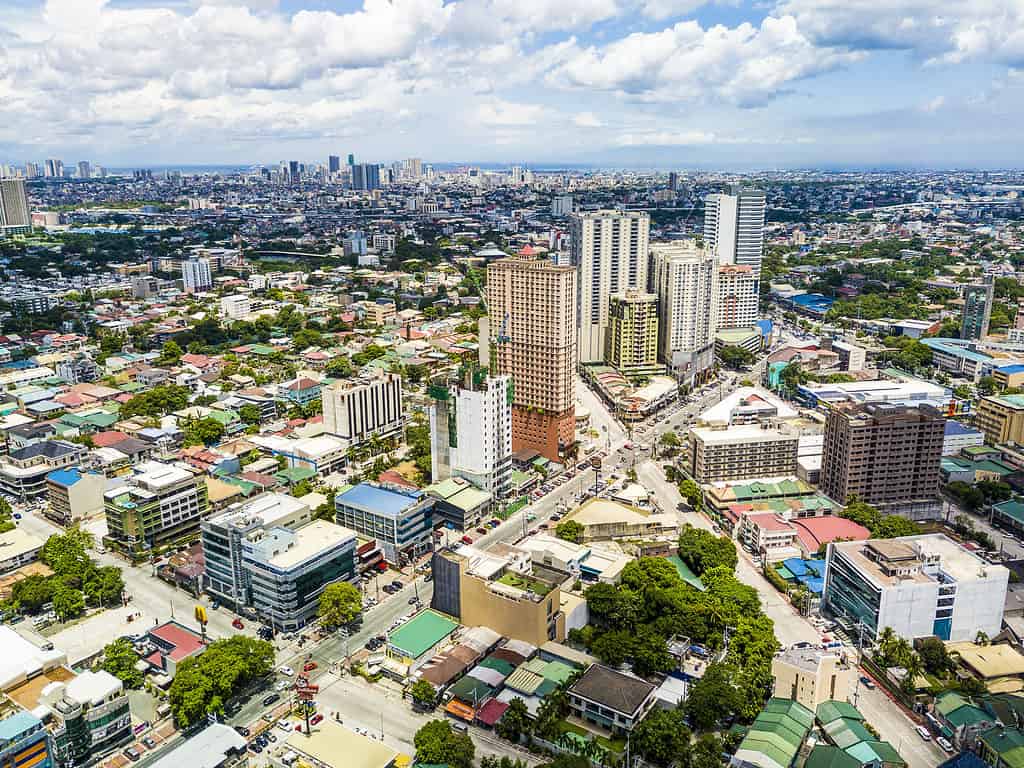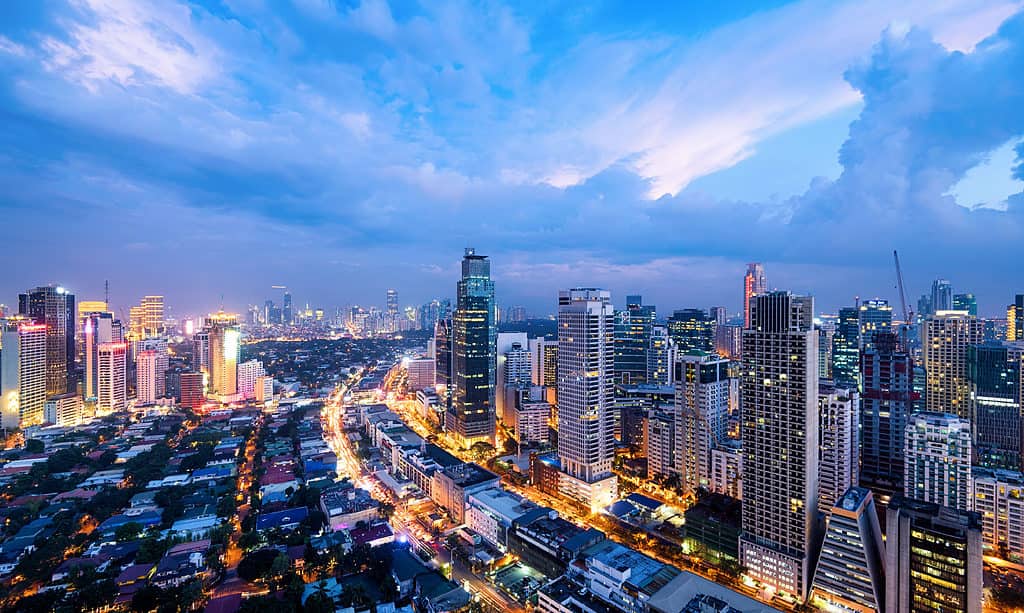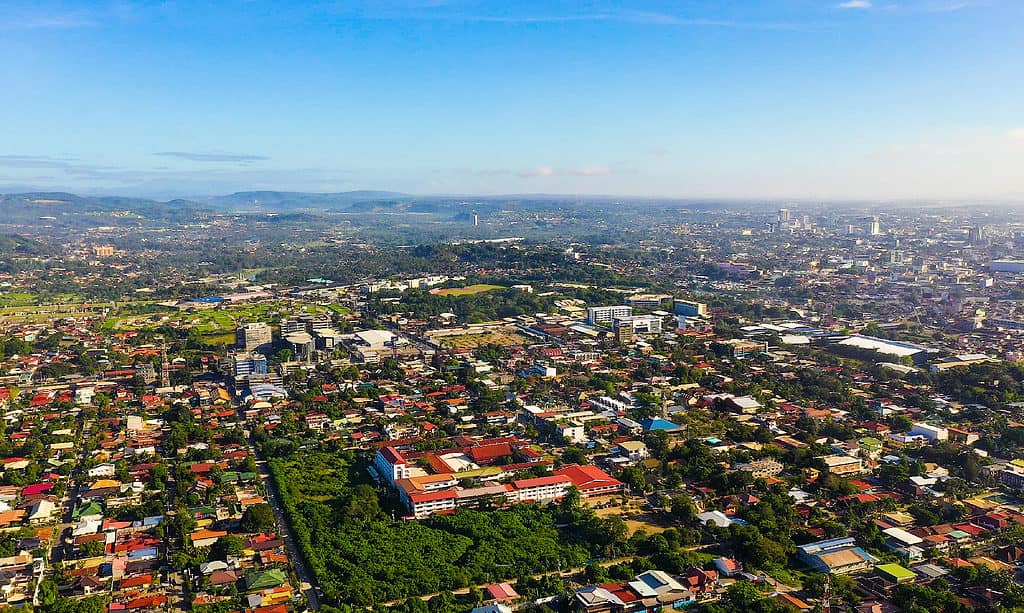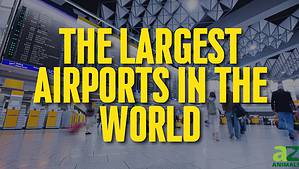The Philippines (officially the Republic of the Philippines) is an island country in Southeast Asia with a total area of 115,831 square miles. It is home to over 115 million people. The country is the 7th most populous in Asia and the 13th most populous in the world. With that kind of population, it is not surprising that the Philippines has some very large cities. Here are the top three:

The Philippines consist of over 7,600 islands that are split into three main geographical divisions: Luzon, Visayas, Mindanao. They form an archipelago created by volcanic eruptions at least 50 million years ago. After the eruptions had stopped, inhabitants of mainland Asia slowly began to migrate, filling up the region. About 30,000 years ago, the region had been almost completely inhabited, and most of the people who settled there were Chinese merchants. Let’s look at the modern cities that have resulted from this long history of growth:
1. Quezon City – 2,960,048

With around 2.9 million residents, Quezon City is the most populated city in the Philippines.
©iStock.com/Michael Edwards
Quezon City is the most populated city in the Philippines, with around 2.9 million inhabitants. Also known as the City of Quezon or Q.C., the city was founded in 1939. It is a planned city, created from smaller towns scattered in the area northeast of Manilla. The president at the time saw a need for a new city that could become the country’s capital because Manila was overcrowded. It was supposed to be named Balintawak City, but was instead named after the second Philippines president, Manuel L. Quezon.
The city covers an area of 62.20 square miles, making it the largest city by land area as well as population in what is now the Metropolitan area of Manila – a megacity when combining Manila and Quezon City and their urban sprawl of sub-cities.
Just like the president at the time had wanted, the city became the capital of the Philippines from 1946 until 1972. Also known as the “City of the Star,” the city is popular for its urban infrastructure and role in the country’s political scene by housing several national government offices.
Because of its interesting architecture and tons of attractions, from parks to museums, to animal centers, the city draws in a lot of tourists from other parts of Asia and around the world. Another thing that attracts tourists to the city is its rich history and diverse cuisine and dining options.
Quezon City sits in the northeast part of Metro Manila. While there are a lot of big companies and emerging industries changing the city’s economic scene, Quezon’s economy is still dominated by small and medium-scale businesses. Apart from the numerous small businesses present, Quezon City’s economy is also supported by various malls, farmers’ markets, amusement parks, a local supermarket chain, and more.
2. City of Manila – 1,850,000

The City of Manila is the capital of the Philippines.
©iStock.com/fazon1
Manila, officially known as the City of Manila, is the capital city of the Philippines and also the second-largest city in terms of population. With over 1.8 million inhabitants, the city is very urbanized and won the award for the world’s most densely populated city a few years ago. Before the arrival of the Spaniards, Manila was referred to by surrounding communities as Ginto (meaning land of gold) or Suvarnadvipa, and became formally known as the Kingdom of Maynila or the “Kota Seludong.” After the arrival of the Spaniards, the name Maynila was hispanized and became Manila.
The city serves as the nation’s commercial, political, social, and cultural hub. For more than four centuries, Manila has served as the capital of the Philippines and as both the country’s main port of entry and the hub of its economic growth. It once lost the title of capital city to Quezon but got it back after a few years. Since the city’s devastation during World War II and its reconstruction, it has had tremendous economic growth; nevertheless, as a result, it is also afflicted with the typical urban issues of pollution, traffic congestion, and overpopulation. The overpopulation faced by the city is caused by the constant rural-urban migration of the inhabitants of the Philippines.
Manila’s architectural styles reflect American, Spanish, Chinese, and Malay influences, a testament to how diverse the city truly is. The city is also the Philippines’ center for trade and finance, as most of the imports and exports of the country pass through the city’s port. Tourism is also an important part of the city’s economy, welcoming over a million tourists each year. The city is home to several museums and buildings that explain its history, malls and shopping centers to find the perfect souvenirs, parks, beaches, volcanoes, good food, and a very exciting street life.
3. Davao City – 1,776,949

The largest city by land area in the Philippines is Davao City.
©iStock.com/Alexpunker
As the third most populated city in the Philippines, Davao City (or just Davao) has a total of over 1.7 million inhabitants. The city has a total land area of 943.48 square miles, making it the largest city in the Philippines by land area. With over 50 small ports included in its commercial area, the city serves as the primary regional hub for southeast Mindanao. Despite being a budding commercial hub, the outer areas of the city are still very rural. It is connected to other major cities in the Philippines by a series of highways and has local and international airports.
The city was built as a Japanese colony before World War II. However, the city was destroyed during the war. The reconstructed city features a charming fusion of Spanish, American, and Moorish influences. Davao City is one of the island’s most significant economies and is known for its urban development and modern facilities.
Apart from being a strong contributor to the advancement of the Philippines’ economy, Davao City is also an attractive tourist spot. Thanks to the airport in the city, it is accessible to tourists from other parts of the country and other countries as well. The city is home to several artificial and natural attractions that keep tourists busy for hours; stunning architecture, beaches, conservation centers, amazing cuisine, etc. Apart from these attractions, tourists also visit the city because it is one of the safest in the country.
Summary of The 3 Most Populated Cities in the Philippines
| Rank in Population | City | Location | Feature |
|---|---|---|---|
| 1. 2,960,048 | Quezon City | Luzon | Interesting architecture and many attractive activities. |
| 2. 1,850,000 | Manila | Luzon | Capital; commercial, political, social, tourism, and cultural hub. |
| 3. 1,776,949 | Davao City | Mindanao | Largest in land area; strong economy, urban development, tourism. |
The photo featured at the top of this post is © iStock.com/fazon1
Sources
- Philippine Statistics Authority, Available here: https://psa.gov.ph/population-and-housing/node/60002
- WorldAtlas, Available here: https://www.worldatlas.com/articles/biggest-cities-in-the-philippines.html
- World Population Review, Available here: https://worldpopulationreview.com/countries/cities/philippines
Thank you for reading! Have some feedback for us? Contact the AZ Animals editorial team.






